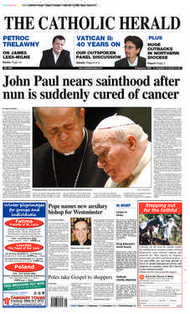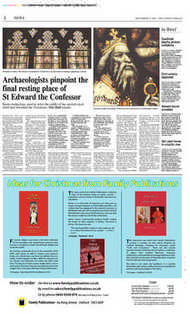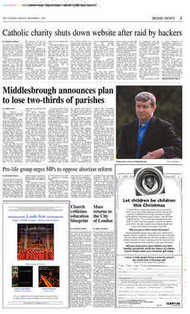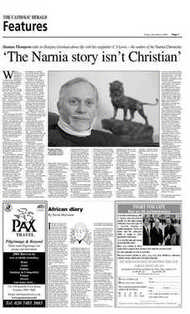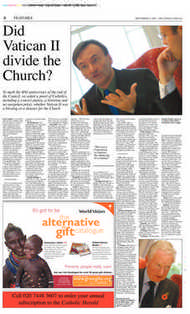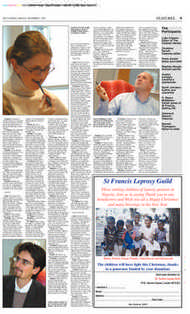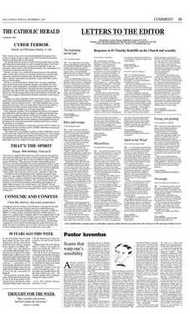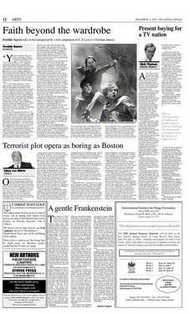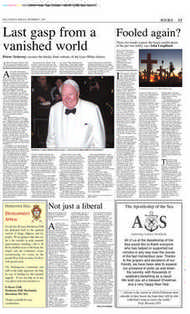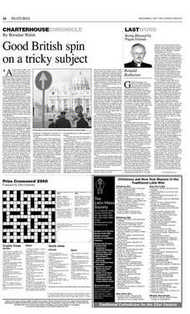Page 3, 9th December 2005
Page 3

Report an error
Noticed an error on this page?If you've noticed an error in this article please click here to report it.
Tags
Share
Related articles
Lay Fury As Diocese Plans Parish Purge
Ask Not What Your Parish Can Do For You...
Middlesbrough Rejects Boundary Changes
Bishop Of Portsmouth Creates New Pastoral Areas In...
Parishes 'twinned' In Diocesan Shake-up
Middlesbrough announces plan to lose two-thirds of parishes
BY FREDDY GRAY
THE DIOCESE of Middlesbrough has published radical plans to shed twothirds of its parishes.
In a consultation paper given out to parishioners this month the diocese lays out a proposal to reduce the number of Middlesbrough parishes from around 85 to 24.
The paper gives extensive statistical data to show how dwindling Mass attendance and the rapidly diminishing number of priests justify the move. By 2050, it predicts, there will be no priests left to serve the diocese.
“Like the other dioceses, we are challenged by the reality of fewer priests and general reducing Mass attendance,” said Bishop John Crowley of Middlesbrough. “That is a fact. If this is a moment for the honest facing of facts within the diocese it is even more a moment of hope for the possibilities which are ours with the help of God.” Fr Derek Turnham, spokesman for the diocese, said the consultation paper was “a document of hope”. He said: “These massively reduced numbers in Mass attendance are no accident. God is up to something and it is up to us to find out what that something is all about.” The suggested “24-parish model” does not mean that the diocese will be left with only 24 churches. Each parish would have a “mother church” with one resident priest who will administer to several churches in his area.
It is understood, however, that the proposals will mean the closure of a number of churches and a significant reduction in the number of Masses celebrated in the diocese, although this is not mentioned in the document.
“Now is not the time to identify buildings for closure,” said Fr Turnham. “In some areas this may be inevitable, but this is something that will have to be sorted out at a local level.” Diocesan authorities stress that the consultation is in its first phase, and that the proposals suggested will change as the diocese receives feedback from the laity.
Some parishioners seem upbeat about the move. “We all know that something has to be done to cope with the lack of priests,” said Joe Harrison, Grand Knight of St Columba in Middlesbrough. “We hope that this can be something positive and we can move forward together with the diocese.” But others doubt whether the diocese will actually follow through with its plans. Mary Scott, a parishioner in Hull, said that most Catholics she knew welcomed the proposals but were “cynical” about what might happen.
“People are very keen that something is done to make the parishes more vibrant. But there is a lot of doubt as to whether the diocese will actually get round to grasping the nettle.” The consultation paper suggests that the diocese be divided up to three vicariates: the north, with 11 parishes, the centre, with seven, and the south, with six.
The new, larger parishes have been given geographical, rather than religious names. For example Ss Leonard and Mary, Malton and St Joseph, Pickering would become simply Malton and Pickering.
The process of shrinking the diocese is already underway. Several parishes have already been amalgamated, or “twinned”. Fr Turnham was unable to give a precise figure of the number of parishes in operation today.
However, he said that the diocese is committed to remaining “transparent” about its administration and finances. “We want parishioners to know exactly what the situation is so that they can help effectively with the process of consultation,” said Fr Turnham.
The diocesan accounts for 2005 will therefore be published in next month’s edition of The Voice, the free diocesan newspaper The diocese was established in 1878, when Pope Leo XIII split the Diocese of Beverley in two to form Leeds and Middlesbrough.
The move was made to accommodate the growing numbers of the faithful in the north-east of England. In 1839 the Catholic population of Yorkshire was 13,000; by 1909 it was 167,027.
However, in recent years Middlesbrough congregations have shrunk rapidly. According to the consultation paper, Mass attendance in the diocese has fallen from 29,957 in 1992 to 19,632 in 2004.
blog comments powered by Disqus


